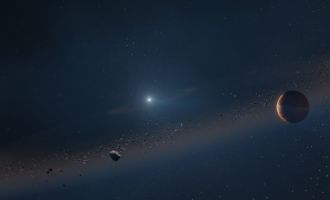Media release
From:
Astronomy: New gas giant planet found orbiting white dwarf star *IMAGES & VIDEOS*
Evidence of a gas-giant, Jupiter-mass planet orbiting a white dwarf star in a wide orbit in the Milky Way is described in a paper published this week in Nature. Although models have implied that planets of this size and in a similar orbit have been able to survive the death of their host stars from the giant phase into white dwarfs, no such planet has previously been observed.
Joshua Blackman and colleagues obtained deep exposures of the field surrounding a Jupiter-mass planet (MOA2010BLG477Lb) discovered previously through microlensing, a technique that is sensitive to cold planets and does not depend on the light from the host star for measurement. Microlensing can also detect remnants of stars such as white dwarfs. The authors determined that this planet formed at the same time as its host star and managed to survive after the star stopped burning hydrogen in its core. Gas-giant planets orbiting white dwarfs are typically thought to move to orbits 5 or 6 astronomical units (AU) away, but this planet is around 2.8 AU from its star.
These findings provide evidence that planets can survive the giant phase of their host star’s evolution, and supports the prediction that over half of white dwarfs are predicted to have similar planetary companions.
Multimedia




 Australia; New Zealand; TAS
Australia; New Zealand; TAS

